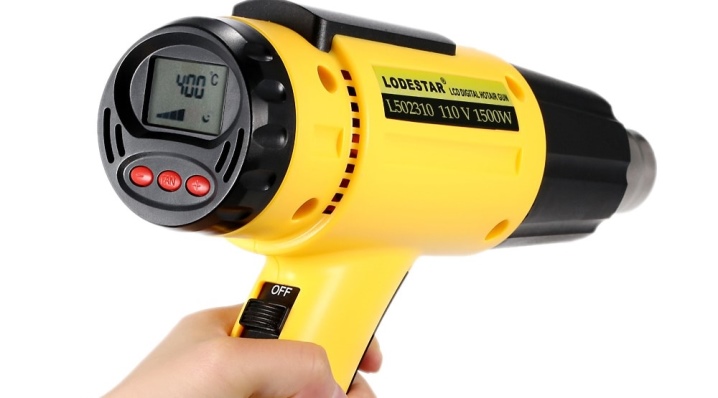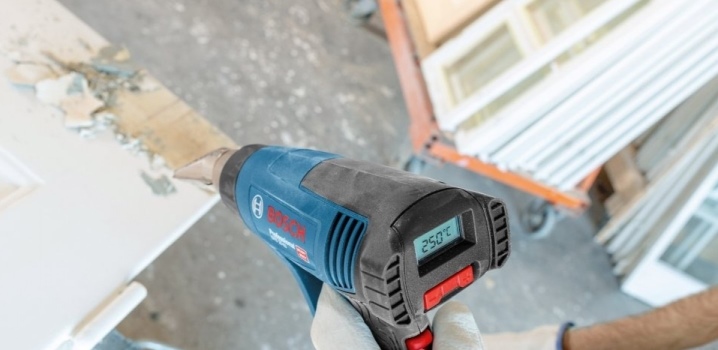Choosing a rechargeable construction hair dryer

A construction hair dryer, in contrast to a cosmetic one, gives a temperature not of 70 degrees at the outlet, but a noticeably higher temperature - from 200. It is used for hot glueless bonding of plastic, heat shrink mounting and other similar work.

Device and principle of operation
The hair dryer itself is not such a complicated device as to be especially expensive and difficult to operate. In the simplest case, hair dryers are made of spirals stretched at the outlet of a fan siphon (similar to an air pump), which are heated to a temperature safe enough not to melt the high-temperature plastic from which both the housing and the fan impeller were made. The cooler (fan) runs on a 12, 24 or 36 volt battery - just like spirals. The air taken in from the room pushes the heat out, preventing the hair dryer from heating up entirely. Blowing over the heated spirals, the siphon provides heat removal - cool air at room temperature turns into hot air.


Modern hair dryers have step switching (or adjustment) of engine speed and / or heating of the blown spirals. The spirals themselves are wound from nichrome wire.
Most of the models of hair dryers are made of heat-resistant plastic - such a case serves as a kind of heat insulator. However, the spirals are wound on non-combustible rods (for example, steel inserts with a non-conductive mica coating, ceramic pins). Each spiral resembles a kind of heating element of a powerful soldering iron, which heats up to hundreds of degrees. The most convenient execution of such a hair dryer is a pistol. The switches (or regulators) of the engine speed and the heating of the spirals are located on the pistol grip. The handle is covered with rubberized material - it prevents accidental slipping out of a sweaty hand during work.

Cordless hair dryers provide a charger connector, and the batteries themselves are located in a special compartment. Technological slots are located on the back of the body through which air is blown in. The grate with spirals is covered with an additional steel mesh - in case of sudden falling into the siphon and on the spiral of small objects and debris. The nozzles are put on the outlet nozzle, forming a jet in a transverse projection.

The hair dryer can be either electromechanical - step switches, spirals, a cooler-type siphon, a bimetallic plate against overheating, opening a relay or switch, or electronic - a full-fledged microcontroller with the same power relays or powerful transistor keys plays the role of a board. The microcontroller circuit can be equipped with a small non-volatile memory chip that retains the last user setting until the next reconfiguration of the device.



Views
A small hot air gun will help in everyday life when the amount of work is small. It is not designed for long-term (within a specific session, lasting up to several hours) use, since the spirals in it are not so powerful, or it is impossible to obtain a heating temperature, say, over 200 degrees.

Autonomous devices operate from a rechargeable battery - built-in or external, which eliminates interruptions in the event of frequent power outages. The cordless hair dryer has either spirals operating from 12-48 volts directly, or is equipped with an inverter that converts, for example, 12 to 110 V.

By the type of body, pistol and straight-body devices are distinguished. The former are safer at work. But the hair dryer with a combined body has a rotary handle, which allows you to adapt it to working conditions with straight-body or pistol devices. The battery capacity of pistol hair dryers is less than straight-case ones - the curved space inside may not accommodate, for example, elongated 18650 lithium-ion batteries.


In a straight-body hair dryer, the space under the battery is quite large in order, for example, to arrange them in a row (6 to 4 volts will give the same voltage at 24 V).
Selection Tips
The power of the hair dryer determines the amount of work. For hair dryers with accumulators, it is lower than for mains. The heating of the spirals allows you to reach a power of up to several hundred watts - for half an hour or an hour of continuous operation. For a longer duration of a work session, a connection is required, for example, to an electric vehicle battery, whose capacity reaches not tens, but hundreds of ampere-hours - in terms of a voltage of 12 or 24 V.
The material of manufacture matters - prefer the sturdiest case. Some models are made with a metal case, in which only a plastic and / or rubberized handle is used for electrical safety purposes. From the point of view of the heater, the nichrome spiral and the ceramic mandrel on which it is wound are the most durable elements in terms of service life.


Air heating temperature also matters. In households, it starts at 250 degrees - this is enough to soften, melt plastic, turning it into a kind of hot melt glue.

Advanced functionality: a variety of attachments, electronic and wireless control, memory of settings, protection against overheating, "cold" mode and a number of other technical capabilities.
Some nozzles are made in the form of narrow nozzles - flat, collecting the flow at one point, cutting (for example, for plastic), lateral, reflective, slotted, mirror and welded, as well as gear and spline types. Some of them, for example, collecting (concentrating), are used to burn holes in plastic and low-melting non-ferrous metal.
Some attachments are made in a garage, which allows you to save a certain amount.
Additional accessories - roller, scraping nozzle, adapters, welding rod, additional handles (replaceable), "suitcase" packaging of the "diplomat" type.














The comment was sent successfully.